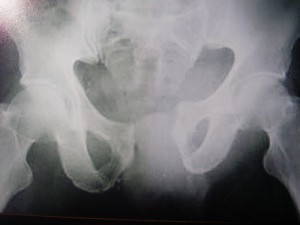
... makes us stronger, as Nietzsche said. A para-gliding accident didn't quite kill Fred Noble, but it was a close-run thing. Further to my blogs on how a split second can turn a person from able-bodied to disabled...
A couple of years ago, when Fred was 67, he had a serious fall while para-gliding in Brazil that forced his femur up into his pelvis, breaking it clean through the middle (which makes my little stress fracture look totally trivial).
Fred spent a full year in recovery, slowly and painfully restoring his body to health. For the early part of the year he was on intravenous morphine. The pain was so bad towards the end of each dosage period that he would be counting down the seconds until he could take his next morphine shot.
He had been an intrepid adventure heli-skiier, used to adrenaline rushes and wide open spaces. But now his perspective had changed. He recalls the day when he was able to put on his own sock - a major victory.
The road to recovery was long and hard, especially for someone no longer in the flush of youth. But eventually his perseverence through months of rehab paid off. He can now walk unaided, and is planning a heli-skiing trip to celebrate his 70th birthday next year.
There must have been many occasions when Fred wondered if he would ever walk again. But he took the big challenge and broke it down. One day trying to touch his toes. Then trying to put on a sock. Then rebuilding the strength in his legs. Little by little, he overcame probably the biggest challenge of his life.
Eric and I stayed with Fred in Portland last weekend, on our way back from Hawaii. We were talking about adventure and risk. Fred commented on how many people say, 'I could never do that', when what they really mean is 'I don't want to do that'. If they DID want to do something, they could find a way. They could come up with a plan, breaking the big challenge down into smaller chunks, or gradually acquiring the necessary skills and confidence, taking it one step at a time.
So often, our limits are the ones that we CHOOSE to impose on ourselves.
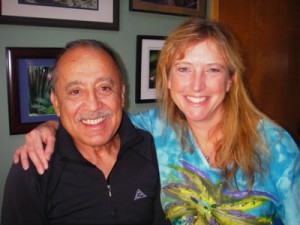
Fred and Roz
|
|
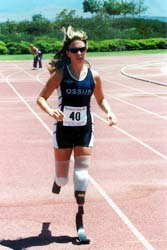
A friend of mine who is disabled (or are we supposed to say 'differently abled' in this age of political correctness? anyway, he walks with the aid of two sticks) has pointed out to me how lucky I am to be able to do the sports I do - or at least, if I can't do them, it's due to general klutzishness rather than lack of physical capacity.
I do, of course, realise this, and am grateful to have a (relatively) fit and healthy body, especially because I am keenly aware how in only a split second I could go from being able-bodied to being disabled. In the world of adrenaline junkiedom, there is any number of salutary tales of people who had a bad accident and lost forever their ability to take part in sports.
There are also the tales of people who suffered awful injuries, and managed to overcome them to continue competing and participating in sport. It would be nice to think that if something bad happened to me, I might have the resilience and strength of character to pick myself up and carry on constructively. I hope I never need to find out. So I'll continue to keep my sports strictly towards the low-adrenaline end of the spectrum.
[Photo: Jami Goldman, runner, who lost both her legs to frostbite when she was 19]
|
|
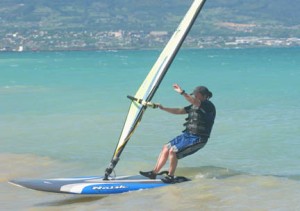
Why do some people assume that because I can row an ocean, I am generally sporty? Don't they know that most rowers row because they can't do anything else?!
I was apprehensive about my first ever windsurfing lesson this morning, and all the more so because my debut was to be photographed for an article in a windsurfing magazine. My sense of balance was quite finely honed after 3.5 months on a tippy little rowboat, but that was 8 months ago now and my legs are firmly re-accustomed to land. My hopes were modest - to spend just enough time on the board so we could get a decent photo.
Then there was the issue of my current camera-shyness. As if it hasn't been bad enough having to display my podgy white self on an island where most women are 100 pounds and brown as berries (much like I was when I arrived in Antigua, come to think of it) now my out-of-shapeness was due to be recorded for posterity. Mortifying.
Actually, it didn't turn out as badly as I'd expected. I'm far from being a natural, but at least I managed to avoid abject humiliation. I got the hang of steering and turning the board, and in an exhilarating run of, oh, at least 10 yards, almost looked like I knew what I was doing.
As for the photos, I'm pinning my hopes on Photoshop to hide a multitude of sins...
After I'd finished messing around on the water we went to watch the pros in action. Maui is hosting the Aloha Classic this week, and our host Matt Pritchard was competing. The weather has been too calm so far this week and even today the waves were apparently seriously substandard, but it was still jaw-dropping to watch the skill of people who REALLY knew what they were doing, especially now that I know just how hard windsurfing is to the uninitiated.
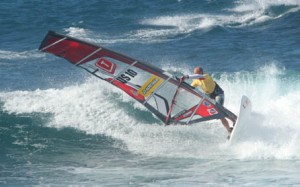
Matt Pritchard in action
|
|
Hi Roz,
I work in the Contingent OPS Cell at Northwood and have been asked by Cdr Hussain to look at the support and routing (given my past experience as a navigator as well as a forecaster) for your rowing expedition. I have come up with what I believe to be a workable plan but there are some issues that will need to be addressed in due course, mainly taking into account your route with respect to weather conditions. The breakdown is as follows:
Part 1 - San Francisco to Honolulu
Distance 2080nm following the great circle route. Leaving in July will mean that you are mainly under the influence of the persisting East Pacific high pressure. Initially you will be affected by cross winds (from the north) as you head southwest from the coast but picking up north easterly wind about a quarter of the way into the route. Once you clear the California Current that runs southwards down the coast of California, the current will also become favourable. July of course is the middle of the Typhoon season in the East Pacific with the systems being spawned off the coast of Mexico and taking a generally west or northwest track which will affect your route. Your actual departure date would need to be dependent on the formation and track of these systems.
Part 2 - Honolulu to South Pacific
The end point I've looked at for this is the Tuvalu Islands (approx 6 South, 175 East). The main island here is Funafuti which also has an airport which will help logistically. The distance here is approx 2200nm. Leaving in March would be beneficial for this stage to take into account the north and south equatorial currents which both run westwards and as you proceed southwest you should meet the counter current (east setting) at its weakest. The north equatorial current and winds would be astern of you down to the equator and then on your port quarter (so still assisting) as you run down to the Islands.
Part 3 - South Pacific to Australia
Here there are more issues which may affect your ultimate destination. To head to Sydney is by far the longest route at 2400 - 2500nm. The main issue here is that the winds will become constantly on the port beam as you pass the Solomon Islands, becoming a head wind as you head down towards Sydney (virtually no change throughout the year). There are two further options, one of which would be to head for Brisbane (approx 2000nm) which would mean that you become affected by crosswinds as you pass the Solomon Islands, but would be spared the head winds if you headed to Sydney. The 3rd option which takes optimum advantage of weather conditions would be to head for Cairns on the North East Peninsular (approx 2100nm). This would mean that as you clear the Solomon Islands the wind would come more from the quarter than the beam so would be of some advantage.
The first two sections appear relatively straightforward, but further analysis will be needed to look at optimum timing but the dates given above look reasonable at this stage. The 3rd phase is obviously more complex and will require much deeper analysis coupled with your requirements for end point and when you wish to carry out the row.
If you have any questions please do not hesitate to get in touch.
Regards,
Jez Braithwaite
Lt Cdr RN
FWOC Contingent Operations
Dear Jez
That is very useful indeed - thank you for your time and effort in producing such a succinct and helpful analysis of the Pacific weather patterns along my intended route.
Re Part 1, I think I will set a provisional departure date of Sunday 8th July 2007, but will be prepared to be flexible if typhoons are developing. Will it really be best to attempt a great circle route, or would I be better off trying to slingshot the East Pacific High?
Re Part 2, good to know the likely optimal time to leave. This gives me a shorter-than-planned break between Part 1 and Part 2, but well worth it for the favourable conditions. Tuvalu sounds a sensible target.
Re Part 3, ocean rowing boats cannot go into a headwind. A beam wind is difficult, but a headwind is impossible. So we can write Sydney off as a potential destination. Cairns sounds like a much better bet. What time of year would be optimal for that route?
With thanks and best wishes
Roz
|
|